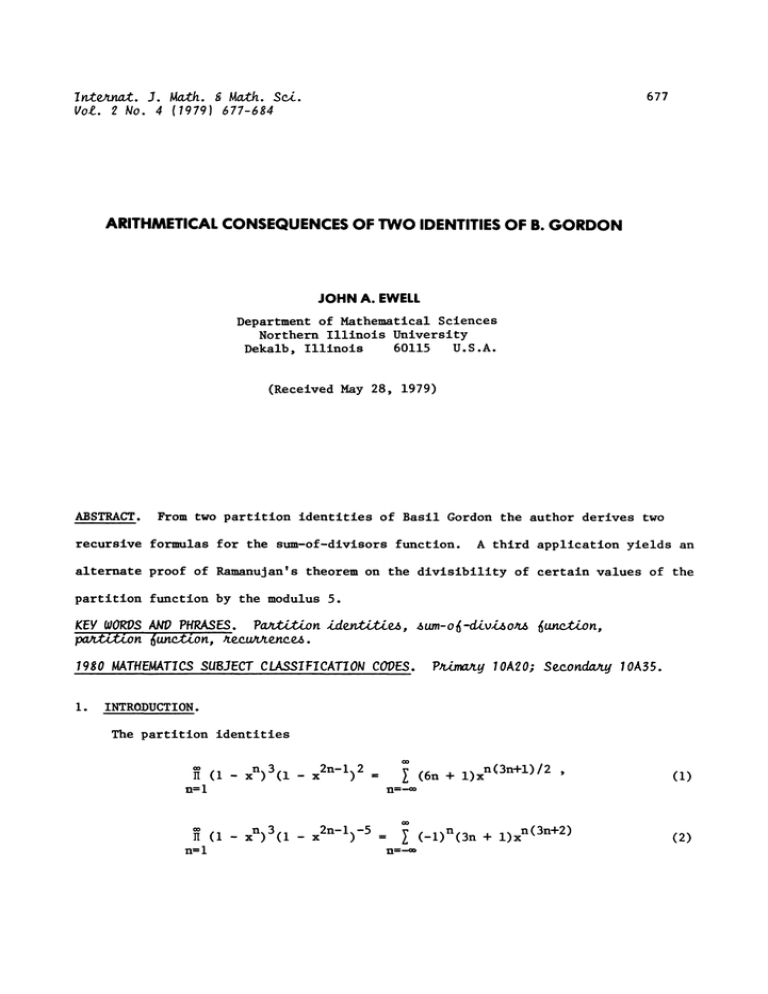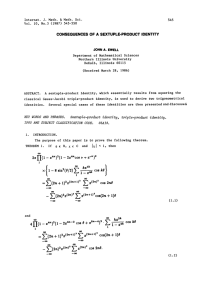ARITHMETICAL
advertisement

I nternat. J. Math. Mh. Sci.
Vol. 2 No. 4 (1979) 677-684
677
ARITHMETICAL CONSEQUENCES OF TWO IDENTITIES OF B. GORDON
JOHN A. EWELL
Department of Mathematical Sciences
Northern Illinois University
U.S.A.
60115
Dekalb, Illinois
(Received May 28, 1979)
ABSTRACT.
From two partition identities of Basil Gordon the author derives two
recursive formulas for the sum-of-divisors function.
A third application yields an
alternate proof of Ramanujan’s theorem on the divisibility of certain values of the
partition function by the modulus 5.
KEV WORDS AND PHRASES.
PtiLon identie,
pon" function, reence.
1980 MATHEMATICS SUBJECT CLASSIFICATION CODES.
1
sum-of-divi6or function,
Primary IOA20; Secondary IOA35.
INTRODUCTION.
The partition identities
(_ _n
,3,_x2n-l) 2
t
n I
II (1
nffi i
n)3,1
x
2n-I)-5
[
(6n + 1)xn(3n+l)/2
(-l)n(3n +
l)xn(3n+2)
(1)
(2)
J.A. EWELL
678
In the present investigation we make three outstanding
were first proved in [3].
As for methods of proof, we follow Euler and
applications of these identities.
Ramanu an.
Euler was the first mathematician to use a partition identity to
Specifically, he used his now famous
gain important arithmetical knowledge.
pentagonal-number ident ity
I (-l)nxn(3n+l)/2
(i- x n)
n---oo
n=l
to derive recursive determinations of the sum-of-dlvlsors function and the
partition function.
Accordingly, let us briefly recall that for each given
positive integer n, o(n) denotes the sum of the positive divisors of n, and p(n)
denotes the number of unrestricted partitions of n; conventionally p[0)
i.
Ramanujan was the first mathematician to observe congruences in certain values of
p relative to the modull 5, 7 and Ii.
Recently, the author observed that Euler’s
technique of logarithmic differentiation (which he applied to his identity to
derive a recursive formula for ) can be extended to identities of the type
a
(i- x n) (i- x
2n-l) b
I +
I C(a,b;
n,
n)x
(3)
n--1
n--1
where (a,b) is an arbitrary pair of real numbers, say, and in all of the interesting
cases the rlght-hand series is lacunary having gaps which increase quadratically in
size.
As a matter of fact, only the special cases:
(1,-2) were
discussed in the papers
[I], [2].
(i,0), (3,0), (I,i),
(a,b)
In addition to Euler’s identity, the
following identities were also used.
(i
n--i
xn)(l
x
2n-l)
I + 2
(-l)n n
I
n--I
2
CONSEQUENCES OF IDENTITIES
ARITHMETICAL
II (i
x
n)(1
x
2n-l
.
-2
n=l
679
xn(n+l)/2
n=0
I
(I- x n)
nffi i
(-l)n( 2n +
i)
xn(n+l)/2
nffiO
The first two are due to Gauss and the third to Jacobi.
The general theorem i
(stated below) contains all of these results, as well as two new recurslve
formulas for o corresponding to the special cases:
(3,2), (3,-5).
(a,b)
statement and proof of the theorem are facilitated by the following
DEFINITION.
of real numbers, we define the function (a,b;
"natural"
2b(n) 0(n),
For each positive integer n, we express n as n
where b(n) is a nonnegatlve integer and 0(n) is odd.
Both
Then, for each pair (a,b)
by (a,b; n)
ao(n) + bo(0(n)).
(There should be no confusion between the constant b and the functional value
b(n) standing for the exponent of the binary part of n.)
THEOREM i.
For each given pair (a,b) of real numbers and for each positive
integer m,
m-i
(a + b){o(2m
Ii o(2m
I) +
I
2k)C(a,b; 2k)}
(4)
m-i
+
(a,b; 2m
I
2k
+ l)C(a, b; 2k
i)
i
-(2m
l)C(a,b; 2m
I)
and
m-1
(a,b; 2m) +
(a,b; 2m- 2k)C(a,b; 2k)
(5)
i
m
+ (a +
b)O(2m
i
2k
+ l)C(a,b; 2k
i)
680
J.A. EWELL
ffi-2mC(a,b; 2m)
Section 2 is dedicated to the proof of theorem 1 and two corollaries.
(i) with the second of Gauss’s identities to give
section 3 we combine identity
an alternate proof of
In
RamannJan’s
theorem concerning the divisibility of the values
p(Sm + 4) by 5.
2.
Briefly, set F(x)
Proof of Theorem i:
1
+
I C(a,b;
n)x
n.
Now take the
logarithmic derivative of identity (3) and multiply the resulting identity by x
to obtain
(a +
b).(2m
l)x
2m-I
1
F(x)
1
(For details, see [i] or [2].)
(a +
xF’(x)
+ .(a,b; 2m)x 2m
b){[C(2m
Now,
l)x2m-l}F(x)
1
(a +
b){[x2m-l((2m
I) +
i
[
(2m
1
2k)C(a,b; 2k))
k-i
m
+
{ [(a,b;
.x2m [ o(2m
I k=l
2k
+ l)C(a,b; 2k
I)}
2m)x2m}F(x)
1
x2m((a,b;
I
2m) +
(a,b; 2m- 2k)C(a,b; 2k))
k-i
+
--Ix 2m-1 k-i[ (a,b;
i
2m- 1- 2k
+ 1)C(a,
b; 2k- 1)
681
ARITHMETICAL CONSEQUENCES OF IDENTITIES
-xF’ (x). Hence,
The sum of these two expansions equals
we equate coefficients
of odd powers to obtain recurrence (4) and equate coefficients of even powers to
obtain recurrence (5).
For the special case (a,b)
(1) as
1
+
(6n
+ 1)xn(3n+l)/2
1
5"(n),
.(6n
1)x
n(3n-1)/2
and observe that
1
(3.2 b(n)+l
(3,2; n)
(3,2), we rewrite the right side of identity
1)-(O(n)).
Although n odd implies that (3,2; n)
we do not separate the arguments by parity in order to gain an easy
statement of
COROLLARY I.i:
For each positive integer n,
(3,2; n)
+
(6k- 1)(3,2; n
(3k2
(6k + 1)(3,2; n
(3k" + k/2)
k)/2)
m)/2,
if n
(3m2
2
-(6m + 1)(3m + m)/2,
if n
(3m + m)/2,
(6m
O,
l)(3m
2
m)/2,
2
otherwise.
As the exponents 3n2 + 2n on the right side of identity (2) are easy to
separate by parity, we here follow the exact statement of our theorem.
But, since
is multiplicative, it suffices to give the specialization of recurrence
(4).
In
order to make the right side of identity (2) have the same form as that of identity
(3), we
(3n
rewrite the right side of identity
l)xn(3n-2)}.
(2) as I +
(-l)n{(3n
+ l)xn(3n+2)
The corresponding recurrence is thus put into a form easier to
J.A. EWELL
682
(A quick calculation shows that roughly
apply.
i <
J
<
2 of
the values o(J),
n, are needed to compute (n) for large n odd.)
COROLLARY 1.2:
G(2m
..
.
For each positive integer m,
I) +
(6k + l)(2m
I
2k(6k + 2))
(6k
l)o(2m
I
2k(6k- 2))
(3k
i)(3,-5; 2m
k=l
k=-i
+
I
(2k- l)(6k
I))
kffil
I
(3k- 2)m(3,-5; 2m- i
(2k- l)(6k- 5))
k--I
-J(3J + l)(3j + 2)/2,
if 2m
I
J(3J + 2)
I)/2,
if 2m
1
J(3J
j(3J
0,
3.
2)(3j
otherwise.
A Theorem of Ramanujan.
THEOREM 2.
2)
The theorem which here concerns us is
For each nonnegative integer m,
p(Sm + 4)
0
(rood 5).
We content ourselves with an outline of how identity (i) and Gauss’s identity
H(I
xn)(l
x
2n-l)
-2
xn(n+l)/2
combine to yield a proof of theorem 2.
,
To this end, we first multiply x and the two identities to obtain
x__(-xn)
where
k
k(r,s)
4
I I
i
(6=+)x
+ r(3r + 1)/2 + s(s + 1)/2.
683
ARIThRETICAL CONSEQUENCES OF IDENTITIES
Next, we prove the following
LEMMA:
For each pair (r,s) of integers, s > 0, if 5 divides k(r,s),
then 5 also divides each of the integers (6r
+ i) 2
and 2(s
+ i) 2 + 3s +
i.
Now,
24k
(6r + i) 2 + 12(s + i) 2
(6r + I)
2
12s
+
+ 2(s + i) 2 + 3s +
i
Hence, the only way to obtain 0 (mod 5) upon adding
and 2(s
+ i) 2 + 3s + I congruent
in particular, if 5 divides
to 0 (mod 5).
(mod 5).
is to have both
(6r + i)
This proves our lemma; and
k(r,s), then 5 divides 6r + i.
We now complete the proof of theorem 2
REMARKS:
ii
"u
[4, pp. 288, 289].
as in
In [2] two triangular-number recursive formulas for
are noted.
Now, with Euler’s formula and that of corollary I.I, we also have two pentagonalnumber formulas.
And, finally in the exponent k(r,s)
i
+ r(3r + 1)/2 + s(s + 1)/2
we have a choice (depending on whether we use the identities of Euler and Jacobi,
as did Ramanujan in his original proof, or the identities of Gauss and Gordon), a
choloeof how we complete squares so as to prove the crucial lemma.
the triangular numbers s(s
the pentagonal numbers r(3r
+ 1)/2
+ 1)/2
On the one hand,
are in the foreground, while on the other hand,
have center stage.
A reasonable guess is that there is only one recursive formula for
involves squares.
least.
which
But, the recurrence of corollary 1.2 is curious, to say the
One glaring poln? of exception revolves about the exponents n(3n
These can hardly be classified with the common figurate numbers.
+ 2).
684
J.A. EWELL
REFERENCES
i.
J.A. Ewell, Recurrences for the sum of divisors,
(1977), 214-218.
2.
J. A. Ewell, Recurslve determination of the sum-of-divisors function, Proc.
Amer. Math. Soc. 73 (1979), 169-172.
3.
B. Gordon, Some identities in combinatorial analysis, Quart. J. Math. Oxford
Ser. (2)12 (1961), 285-290.
4.
G. H. Hardy and E. M. Wright, An introduction to the theory of numbers, 4th ed.,
Clarendon Press, Oxford, 1960.
Proc. Amer.
Math. Soc. 64







